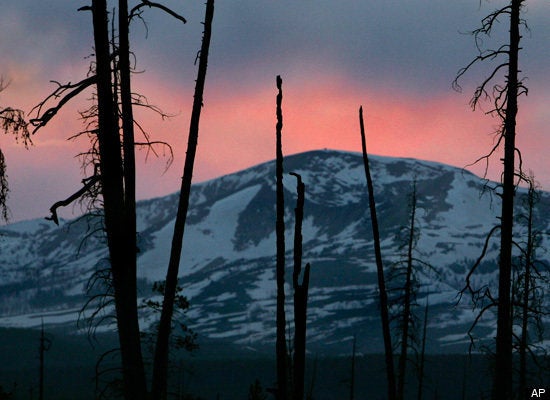
July 21, 2010, 9:35 a.m.: In preparing for the public release of the first-ever comprehensive assessment of the climate-driven mountain pine beetle outbreak in whitebark pine forests of the Greater Yellowstone Ecosystem, those of us involved in this multi-year project have a huddle on the phone. My old friend and brave pilot, Bruce Gordon, who flew the entire ecosystem last summer—all 21 mountain ranges in a 25 million acre region —to collect an enormous data set on whitebark pine damage starts in: “Hey guys, flying this summer, I can hardly find any of those big expanses of red whitebark pine trees.” These vast “seas of red” are the tell-tale signs of a mountain pine beetle outbreak in whitebark pine—an outbreak that has outstripped any that have been seen to date, due to warming temperatures.
9:40 a.m.: World-renowned beetle expert Dr. Jesse Logan, and one of the leaders of this research project responds: “I’ve been seeing the same thing on the ground, Bruce, and I think it’s because the outbreak is already waning because the food source is gone. You are probably seeing now more of the grey ghost forests, the residual of past outbreaks. You would expect this after the food source [here, whitebark pine] has been exhausted.”
Gone. Gone. Wow.
“We’ve been saying that whitebark pine will be functionally lost in the ecosystem. I would say now that whitebark pine has already been functionally lost in much of the ecosystem,” Jesse announces flatly.
The words hit like a slammed door. Lost. These trees, some of them over a thousand years old, trees that survived all of the slings and arrows that nature could throw at them since the Pleistocene—lightning, harsh winters, one hundred mile per hour winds—are now functionally lost in much of the Greater Yellowstone Ecosystem, as a result of an unprecedented epidemic of mountain pine beetles. And with them go a whole host of ecosystem functions once provided by these magnificent forests.
9:45 a.m.: Co-collaborator and GIS whiz Wally MacFarlane says: “All summer at our Treefight field trips, we’ve hardly been able to find stands of 40 healthy trees to protect with Verbenone. (Verbenone is a chemical compound that may help protect pine trees, by signaling to the beetles that the tree is already fully occupied by their brethren.)
9:47 a.m.: Dead silence for at least one minute, as we take in this terrible truth.
10:45 a.m.: Old friend and outfitter Meredith Taylor calls to report that she is going out to work for the next three weeks on a prehistoric archeological site at 10, 500 feet elevation, where Native Americans collected and ground up whitebark pine seeds using manos and metates (grinding stones) – which they likely mixed with berries and the fat of elk as well as bighorn sheep, which they drove of nearby cliffs, to make pemmican to survive the long winter. She asks what she can do to help our citizen science efforts we are pursuing this summer. “Lots,” I say. “And thank you!” Meredith is one of a number of wilderness veterans who is deeply concerned about whitebark pine, and has been collecting important observational data over the last number of years.
11:00 a.m.: Our media call begins, and I go over the key findings of the project report titled “Using Landscape Assessment System (LAS) to Assess Mountain Pine Beetle-Caused Mortality of Whitebark Pine in the Greater Yellowstone Ecosystem.” A whopping 95% of whitebark pine forests (by sub-watershed) have been affected by mountain pine beetles, and 82% have had significant (medium to high) mortality.
11:15 a.m.: Gib Matthews of the Powell Tribune asks, “So of the whitebark pine, 51% is dead?” Answer: Yes. Over half of the whitebark pine ecosystem, by sub-watershed, has been killed or largely killed by mountain pine beetle in less than a decade in the Greater Yellowstone.
11:20 a.m.: Gib Matthews, again: “So are there defenses in whitebark pine from beetles or blister rust?” Answer: No and Yes. So far, only a couple of the trees (literally two) have been found to be successful in fending off beetle attacks, using chemical and physical responses similar to those in lower-elevation tree species, such as lodgepole pine and Douglas fir. Unlike the whitebark pine, these lower elevation trees have co-evolved with the native mountain pine beetle, and thus have developed sophisticated physical and chemical responses. However, there have been a number of whitebark pine trees found to be resistant to the nonnative pathogen white pine blister rust, which has been a major threat to whitebark and other five-needled pines since the early 20th century. Roughly 50% of the historical whitebark pine forests have been killed in the Rocky Mountain region by blister rust. The U.S. Forest Service, National Park Service, academics and other experts have been and continue to work hard to collect cones from apparent blister-rust resistant trees for future restoration planting in the wild.
11:30 a.m.: Kim Murphy of the L.A. Times: “What difference does this make to the Yellowstone grizzly bear?” Answer: whitebark pine drives the vital rates of the Yellowstone grizzly bear population. It is more closely tied to the health of the Yellowstone grizzly population than any other food source is to any other grizzly bear population in the world. Whitebark pine drives reproductive success, because females that have fattened themselves on whitebark pine seeds produce larger litters. And whitebark pine affects mortality rates, because bears feeding in whitebark pine ecosystems are typically in some of the most remote areas in Yellowstone National Park and the surrounding wilderness areas — far away from humans, especially hunters. Several scientific studies have clearly shown that when whitebark pine seed crops are poor, grizzly bears come into more frequent contact with humans and die at higher rates. So, while there are alternative foods for grizzly bears to eat, such as elk in the fall, the pursuit of elk by grizzlies--especially females with cubs--is a highly risky enterprise because of hunters carrying guns.
11:33 a.m.: Molly Messick of Wyoming Public Radio: “So what are the consequences of losing whitebark pine in the ecosystem?” Answer: First, there will be major adverse impacts to the watersheds, especially since the Greater Yellowstone Ecosystem is the headwaters of three major drainages of the West: the Snake/Columbia, the Green/Colorado, and the Yellowstone/Missouri/Mississippi. With the loss of whitebark pine, we expect earlier snowpack runoff in the spring, which will adversely affect fisheries and downstream communities, as well as agriculture. Further, avalanche activity may worsen, because the high elevation forests, which formerly held the snowpack, are greatly reduced.
We will also see adverse consequences to wildlife that depend on the food and shelter provided in this otherwise inauspicious high-elevation habitat: squirrels, chipmunks, grosbeaks, nutcrackers, elk and grizzly bears. There are threshold effects for some of these wildlife species—when seeds crops are too small, for example, Clark’s nutcrackers just leave, and take with them their capacity to help replant whitebark pine. There are thresholds, too, for squirrels, which also cannot survive in stands without enough nutritious seeds. And in the case of grizzly bears, we can anticipate higher mortality rates and fewer cubs over time as whitebark pine further declines in the Greater Yellowstone ecosystem.
12:15 p.m.: While getting lunch at my local favorite restaurant, Mustang Catering, co-owner and friend Dan Sullivan asks me what I’m up to. I tell him the results of our report. To my surprise, Dan, with an apron full of food stains, takes off his glasses and bursts into tears. Dan has logged many miles in grizzly country with his friend, bear expert Doug Peacock. “I remember the most beautiful bear scats were the blond ones, those filled with pine seeds.”
12:30 p.m.: I take my beloved dog Tashi on a walk by the Yellowstone River and look up at the red-stained Livingston Peak at the northern end of the Absaroka Mountains, which extend southward through Yellowstone to Wyoming. Its whitebark pine have been heavily hit by mountain pine beetles.
Eating my sandwich, I ask myself: “So how do we take in such a tragedy of such a scale?” It seems unimaginable that we could have lost such ancient forests in the blink of an eye—less than a decade. Answer, for today: step by step, moment by moment. Each of us has to individually and collectively figure out how to turn the thermostat down, how to protect the ecosystems that our very lives depend on—as well as the lives of the voiceless ones who have no vote in Congress.
Openness. Openness to change, openness to new answers, openness to new perspectives, openness to adapting ecosystem, I conclude is my answer today to this tragic event.
With openness, too, may come new enthusiasm, new approaches by the next generation to respond in new creative ways. Today I only can grieve. Data is data, the truth is the truth. We have lost so much, so quickly, but so much yet needs to be done.
1:00 p.m.: Back to work on the press release, and my blog.
2:45 p.m.: Molly Messick of Wyoming Public Radio calls back to interview me on the question of what we hope to accomplish with the ESA listing petition for whitebark pine. (Earlier this week, the U.S. Fish and Wildlife Service announced a positive “90 day finding” for the whitebark pine petition we filed about a year and a half ago, meaning that they will move ahead with a thorough evaluation to determine whether the species should be put on the endangered species list. I respond that there are three major things endangered species protections would provide: 1.) more resources for research and much-needed restoration efforts; 2.) a higher level of priority and focus by land-managing agencies on whitebark pine, which has been given relatively little attention compared to lodgepole and other tree species that provide valuable timber; and, 3.) requirements to use the best available science and precautionary approaches, to avoid further damage and help recover the species.
3:30 p.m.: David Cook of the Bighorn Radio Network calls from Cody to ask if our agenda with this report is to push Cap and Trade Climate reforms. I take an inhale and laugh out loud. “You could not be talking to anyone in NRDC with less knowledge about the complexities of the cap and trade issue,” I respond. “No, our goal is to bear witness to the loss of an irreplaceable forest ecosystem, and to work with agencies, experts and other collaborators on the most intelligent ways to respond.” I say. He then invites me to engage in his call-in show, which he warns me is listened to by many right-wing conspiracy types. Fine, I say. Bring it on.
5:30 p.m.: Wally MacFarlane calls to debrief the day. I read him the blog draft I have written. He starts to choke up and I swiftly shift the topic to citizen science data collection plans for the summer. The weight of what is happening to whitebark pine is sometimes more than our small army of “whitebark warriors” can bear. We have to help each other endure the pain of the loss of these forests. Bearing witness to the truth here is, at times, overwhelming. Wally and I share the love of these forest systems and have walked, together, through too many dead whitebark pine stands, silent as graveyards.
9:00 p.m.: I lose all my edits in my draft blog, and stalwart Janet Barwick comes in to help out yours truly, who is a computer luddite. No can do. Decide to pack it in and head home with Tashi, who demonstrates by whining that it is long past dinnertime. Tomorrow is another day, and maybe my computer will cooperate.
